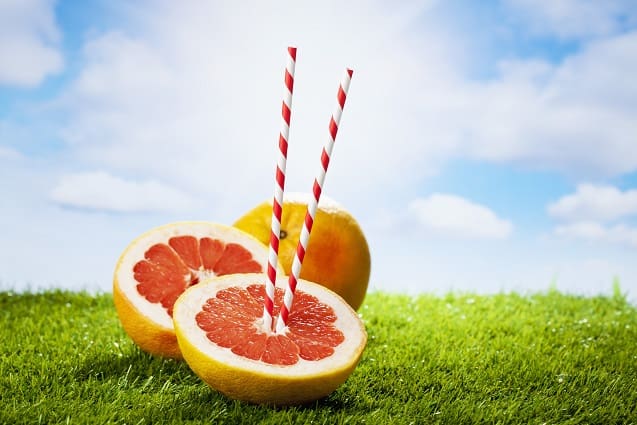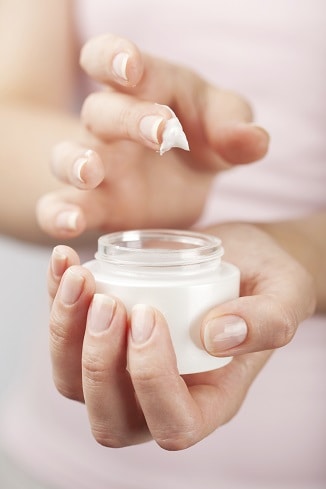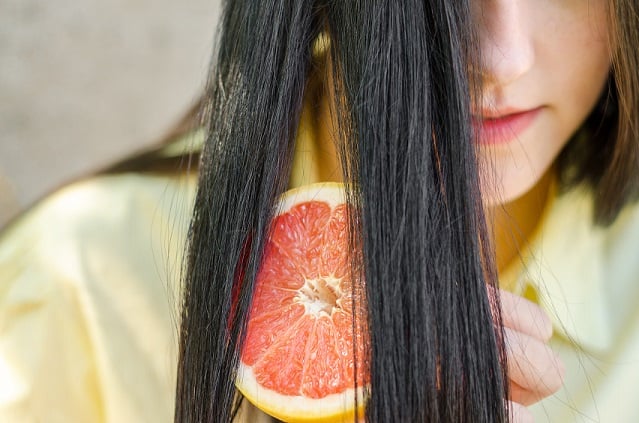The grapefruit is perhaps the most recent fruit to enter the human diet. Fig trees for example, were first domesticated 12,000 years ago in the modern day city of Jericho in the West Bank. Peaches are even older, as prehistoric peach pits dating back 2.5 million years have been unearthed in China.
The grapefruit, meanwhile, was first bred in Jamaica in the 17th century, as a hybrid of a sweet orange and a pomelo, by a mysterious figure of legend called Captain Shaddock. It’s assumed that Shaddock was a member of the British East India sea company, but whether this sea captain really created the grapefruit (or even existed) is a mystery that continues to this day…
…and another mystery, which we will now solve, is whether grapefruit is beneficial for acne.
The perils of grapefruit – very few
Grapefruit gets off to a flying start, as they rank among the lowest fruits in sugar content. Raspberries and strawberries contain below 5 grams of sugar, while green grapes contain 15 grams. A red/pink grapefruit contains approximately 6.9 grams of sugar, while the white subspecies is little different at precisely 7 grams.
Grapefruits are also among the least FODMAP-rich fruits, and therefore won’t inflame your acne if foods like apples, pears, apricots and onions mysteriously do so.
All is well with the traditional fruit villains, but then there’s the notorious medication interference. Grapefruits contain a set of compounds called furocoumarins and one flavonoid called naringenin which can decrease the human body’s CYP3A4 activity.
This enzyme metabolises many hormones and chemicals, reducing their levels in the bloodstream, including many pharmaceutical medications like statins. The inhibition lasts for 48 to 72 hours; the furocoumarins function by binding to CYP3A4 molecules and irreversibly inactivating them. It then takes two plus days to generate more.
Read Annihilate Your Acne – get the greatest diet ever for clear and radiant skin
The results in A) medications staying in the bloodstream for too long, or B) “pro-drugs” becoming ineffective, since they function by metabolising into another compound. Doctors prescribing drugs commonly advise against eating grapefruit. Next time you wake up in hospital, take a look around and observe the complete lack of grapefruit.
Firstly then, avoid grapefruit if you’re on any medications. Secondly, this power might affect acne, because testosterone is partially metabolised by the CYP3A4 enzyme.
Therefore, feasting on grapefruit each day might increase your testosterone levels. Bodybuilders have been speculating about this for years. If you’re a man, more testosterone is perfectly acceptable, but if you’re a woman, the result could be a sudden flood of oily skin.
Similarly, grapefruit might increase cortisol, the main stress hormone. This study analysed both grapefruit juice and licorice root, and observed a shift in the ratio towards cortisol and away from cortisone, a much less active stress hormone. Inactivation of 11β-HSD was responsible; this is the main enzyme which converts cortisol to cortisone.
Grapefruit has even been speculated to prolong the effects of caffeine. Two enzymes break down bloodstream caffeine: another enzyme called CYP1A2 metabolises 86% and CYP3A4 itself metabolises a small portion. Less of these enzymes equals more jitteriness, alertness, and caffeine madness generally.
The problem for acne would be extra stress hormones, since caffeine spikes them significantly. But luckily, the evidence is weaker here. This study gave either A) caffeine and water or B) caffeine and grapefruit juice to ten volunteers, and noted no different in the caffeine half life.
It could still happen because one of the compounds in grapefruit, called naringin, was shown to inhibit both of the enzymes. Additionally, the CYP3A4 inhibition could affect a factor we’re unaware of; maybe pesticides in fruits and vegetables will stay in the bloodstream for longer.
But overall, grapefruits are fairly harmless for acne when eaten.
Grapefruit: seems like nothing special for acne…
At first glance, however, they’re pretty weak for clearing acne as well. The greatest acne nutrients in grapefruit are vitamin C and vitamin A, with 52% and 23% of the daily allowance respectively. Grapefruit therefore has minor benefits for collagen production and oily skin respectively, but its close relative the orange beats it easily, with a whopping 88% for vitamin C. For vitamin A, there’s dozens of richer foods, such as sweet potatoes and carrots.
The acne benefit which fruits almost always have is antioxidants. Pink or red grapefruit has a high score of 1548 on the ORAC scale, but actual studies are weak. This study seemed like a death knell, as whole grapefruit was fed to 69 overweight humans twice daily for six weeks, and resulted in no significant reduction in oxidative stress.
It was the same story for chronic inflammation, the number one cause of acne. This study did observe a 21% reduction in C-reactive protein, the main biomarker of inflammation that scientists search for. But our first study observed no fall. It looks like grapefruit is weak, particularly compared to pineapple where the anti-inflammatory powers calm and soothe all caught in their path.
…but its signature compound is
Yet if you observe the more obscure phytonutrients, a very different picture emerges. Naringin is a flavonoid antioxidant which is found in oranges, but most abundantly in grapefruit. It provides the bitter portion of grapefruit’s signature taste, and is often removed from the juice to make it more palatable. It is effectively grapefruit’s signature compound like bromelain in pineapple or magniferin in mangos.
Naringin has interesting powers like enhancing taste buds and your enjoyment of food, and it’s partially responsible for inhibiting the CYP3A4 enzyme, but these studies on inflammation are more important:
ONE – two closely related citrus flavonoids, naringin and naringenin were reviewed. Both were said to be “strongly anti-inflammatory”, inhibiting pro-inflammatory chemicals like TNF-a.
TWO – scientists blew cigarette smoke in some innocent rats’ faces (study), or least exposed them to smoke somehow. Naringin was applied and all pro-inflammatory chemicals fell again, including neutrophils, TNF-a and IL-8. Acne prone skin contains too much of all three.
THREE – our next group of rats had cognitive impairments (study), partially caused by elevated pro-inflammatory chemicals. Luckily, they were saved from this fate by a dose of naringin, as measured by their successful escape from a water maze they were placed in.
The studies on antioxidant powers were equally interesting:
ONE – in the same study, it was observed that oxidative stress in rats treated with naringin was “significantly lower”.
TWO – naringin is also able to increase numerous antioxidant enzymes in rats including glutathione reductase, superoxide dismutase, catalase and glutathione peroxidase (study).
THREE – a study analysed the antioxidant properties of both naringin and naringenin. Both were strong, but naringenin was stronger. Luckily humanity has prepared for this day, as naringin is metabolised into naringenin in the digestive system.
Grapefruit is a pretty weak fruit for acne when analysed alone, but one of its classic compounds is the opposite.
Most importantly, the flesh of a whole grapefruit from New Zealand was once determined to contain 730mg. This study concluded that just 400mg of naringin daily was sufficient to lower total plasma cholesterol by 14% in people with elevated levels. Therefore, grapefruit should easily contain enough naringin to actually affect acne.
Naringen isn’t the only grapefruit antioxidant either, as the red and pink versions (but not white) contain 1135ug of lycopene. We’ve already covered how lycopene is strongly anti-inflammatory here, as well as UV-protective. Watermelon (4532ug) and tomatoes (3041ug) contain far more, but grapefruits are a strong source as well.
Grapefruit – the enemy of clogged pores?

Another theoretical power of grapefruit is ending oily skin, for the raw fruit has the power of enhancing insulin sensitivity. We have a clear study, as 91 obese people ate either fresh grapefruit or a placebo. After 12 weeks, the grapefruit gang experienced improved insulin resistance and lowered two-hour post-glucose insulin levels.
Apparently “the mechanism is unknown”, but it looks like our old friend naringin is responsible again. Naringin is able to increase glucose uptake in human muscle cells and possibly human liver cells. It upregulates an enzyme called AMPK, which senses incoming glucose. With energy storage taking place much more easily, less insulin is required to force it in, which allows your blood levels to fall.
The 7 greatest topical treatments for naturally clear skin
If the reduction in insulin doesn’t only occur in obese patients, and if the naringin isn’t outweighed by another compound, grapefruit might have the ability to lower insulin and thus your skin’s sebum production.
There’s actually many websites claiming that topical grapefruit cleansers can unclog pores, by burning through the sebum and skin cells with citric acid. But no – EATING grapefruit is smartest.
What about the other topical powers?

Grapefruit is a definite no-go for topical application, because of its content of furocoumarins. Like lemon, parsley, figs and all other citrus fruits, grapefruit is rich in psoralen. This furocoumarin is highly photosensitising to human skin, swelling to three times its normal size when exposed to sunlight and releasing a burst of radiation.
Grapefruit is also the richest source of two rarer furocoumarins: bergamottin and 6′,7′-Dihydroxybergamottin (DHB). It’s these two which inhibit the CYP3A4 enzyme along with naringin, but weakening your skin is another tool in their box.
Among the furocoumarin class, psoralen, 5-methoxypsoralen (or bergapten), and 8-methoxypsoralen are the deadliest. However, bergamottin and DHB are also moderately photosensitising, both to animal and human skin.
Coupled with the psolaren itself, you should definitely stay away from grapefruit topical treatments, particularly if you have naturally sensitive skin. Grapefruit ointments and grapefruit essential oils are recommended widely these days, but always remember! Just because a food is acne-friendly when eaten does not mean that a topical version will succeed fantastically. Olive oil is the only example you need.
BONUS – the grapefruit diet
In your long journey towards clear skin (or your short journey if you read this article), word may reach you that a grapefruit diet exists. It originated in the 1930s and was heavily promoted in the 1970s; the argument was that eating just half a grapefruit or eight ounces of juice with each meal would allow you to shed 10 pounds in 12 days.
Grapefruit is undeniably a low calorie fruit, but it’s claimed that the fruit literally melts fat away thanks to a special enzyme which stokes the metabolic flames. An alternative theory is that grapefruit is an appetite suppressant.
Is there any truth to it? Well, the grapefruit diet consists of approximately 800 daily calories. That amount would have anybody losing weight, regardless of any special powers…
…but those powers may still exist, according to this study which featured four groups on four diets. Their weight loss was: 1.6kg (whole grapefruit), 1.5kg (grapefruit juice), 1.1kg (grapefruit extract pill) and 0.3kg (placebo). It was an easy victory for the grapefruit. Their diet was identical otherwise.
As for the miracle enzyme? It isn’t an enzyme at all; it might be naringin again. Both naringin and its relative naringenin can upregulate a receptor called PPAR-alpha which accelerates the metabolism and weight loss.
You should definitely ignore the official grapefruit diet itself; there’s many weird aspects like increased bacon consumption, which apparently works synergistically with grapefruit to burn fat. That was probably slyly inserted to capitalise on the eternal, never-ceasing bacon hunger. The grapefruit diet is a zero exercise diet as well, and you’d lose many benefits like blood flow and reduced inflammation.
However, the doctor who originally invented the grapefruit diet might have had sincere intentions, before the diet mutated into the failed version of today.
The final judgement
Grapefruits are one of the weaker fruits for acne since they’re completely trapped in limbo. The naringin is promising, and several good studies on grapefruit exist, but it’s strange that a 69 strong human study observed no reduction in inflammation at all.
I’d judge that grapefruits are somewhat anti-inflammatory, but not as powerfully as pineapple or blueberries. The powers for insulin sensitivity and oily skin are more interesting since they’re rare among fruits.
The downsides of grapefruit are circumstantial. The unproven testosterone increase might affect women. The cortisol is the only real threat, if you have a stressful life.
Overall, my recommendation for acne is to do nothing. If you love grapefruits, carry on; if you hate them, eat pomegranate instead. Unless of course, you decide to experiment with them and make an amazing discovery for yourself.
NEXT: the ultimate diet for clearing acne permanently
Thanks for reading!


In the article you say expose mangoes to sunlight before and then after cutting. So which is it?